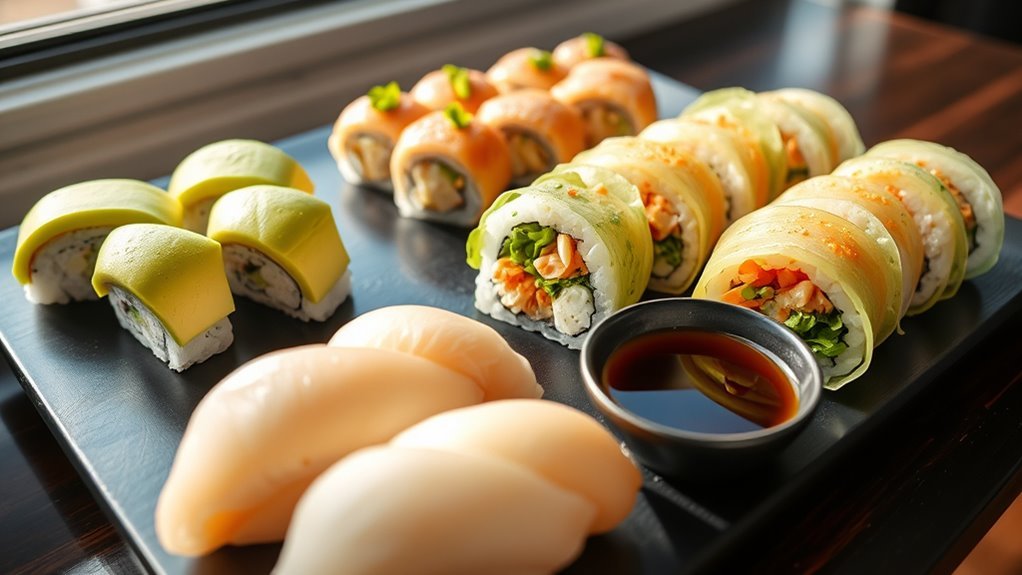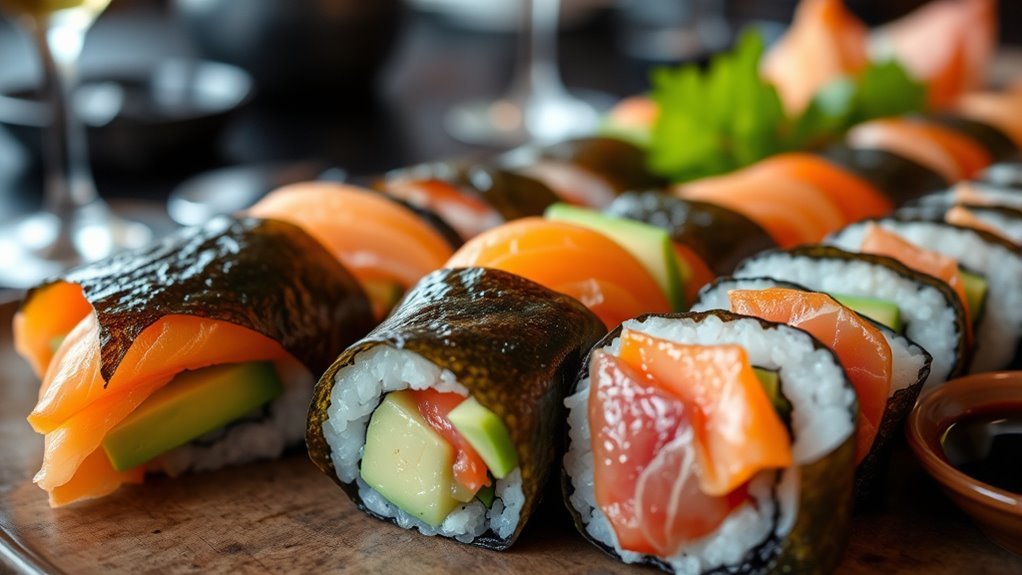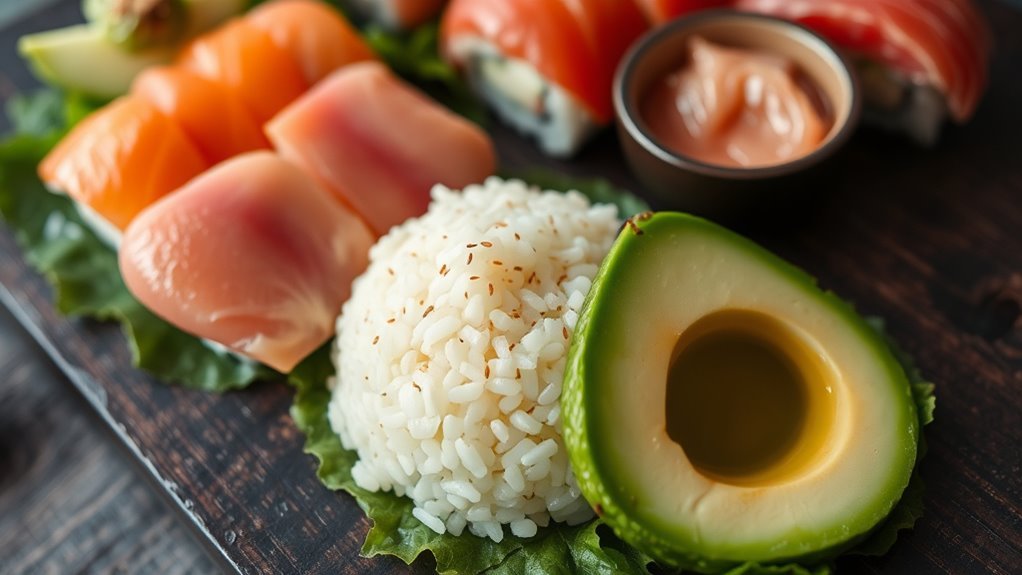Yes, sushi can be keto-friendly if you choose wisely. Focus on low-carb options like sashimi or rolls wrapped in cucumber instead of traditional rice. Avoid high-carb ingredients like sweet sauces, tempura, and rice. Opt for healthy toppings like avocado and use soy sauce or coconut aminos for dipping. Making your own sushi at home is a great way to control ingredients. If you’re interested, there are more tips and alternatives to help you enjoy sushi while staying keto.
Understanding the Keto Diet

When you plunge into the keto diet, you’re embracing a low-carbohydrate, high-fat eating plan designed to shift your body into a state of ketosis, where it burns fat for fuel instead of carbohydrates. The keto basics focus on minimizing your carb intake—usually to about 20-50 grams per day—allowing your body to adapt to using fat as its primary energy source. Key diet principles include consuming healthy fats, moderate protein, and very few carbs. This shift can lead to numerous benefits, such as weight loss and improved energy levels. However, it’s essential to stay informed about food choices, as not all fats are equal. Understanding these fundamentals empowers you to make choices that align with your health goals while enjoying the freedom of your dietary journey.
The Carb Content in Traditional Sushi

When you think about traditional sushi, it’s hard to ignore the rice, which is a significant source of carbohydrates. While the fish itself is low in carbs and packed with protein, the rice often makes sushi less keto-friendly. Luckily, there are alternative ingredients you can consider to enjoy sushi without compromising your low-carb diet.
Rice and Carbohydrates
Although sushi is often celebrated for its fresh ingredients and unique flavors, the traditional rice component considerably contributes to its carbohydrate content. One serving of sushi rice can pack in around 30 grams of carbs, which might disrupt your keto goals. If you’re looking for carb alternatives, consider options like cauliflower rice or zucchini noodles.
| Type of Sushi | Carb Content (g) |
|---|---|
| Traditional Roll | 30 |
| Cauliflower Roll | 8 |
| Zucchini Noodle Roll | 5 |
Choosing sushi made with these alternatives can help you enjoy the flavors you love while staying within your carb limits. So, when opting for sushi, think carefully about the rice and explore creative substitutes.
Fish and Low-Carb Options
While sushi rice tends to be high in carbohydrates, the fish and other low-carb options found in sushi can be a great choice for those on a keto diet. You can explore various sushi types, focusing on fish varieties like salmon, tuna, and mackerel, which are excellent protein sources. To enhance your meal combinations, consider low-carb toppings such as avocado or cucumber. The benefits of seaweed, rich in nutrients and low in carbs, can add unique flavor profiles to your dishes. When dining out, opt for sashimi or nigiri without rice, or try ingredient swaps for a keto twist. With thoughtful meal prep, you can enjoy satisfying sushi that aligns with your dietary goals.
Alternative Sushi Ingredients
Sushi can be a delightful culinary experience, but the traditional ingredients often come with a hefty carb load, primarily due to sushi rice. If you’re looking to enjoy sushi while keeping your carb intake low, consider alternative ingredients. Instead of rice, you can use cauliflower rice or even thinly sliced avocado as a base. These options not only reduce carbs but also add unique flavors. Additionally, incorporating low-carb vegetables like cucumber or zucchini can enhance your rolls while keeping them light. You might also explore using nori wraps filled with fresh fish and these vegetables, creating a satisfying meal without the guilt. Embracing these alternatives allows you to enjoy sushi without sacrificing your dietary goals.
Keto-Friendly Sushi Options

When you’re following a keto diet, enjoying sushi might seem challenging, but there are plenty of delicious options that fit your low-carb lifestyle. Opt for keto sushi made with cucumber wraps or seaweed instead of rice. Many sushi restaurants offer creative rolls that substitute rice with avocados or cauliflower, which can be both tasty and satisfying.
When it comes to sushi toppings, you can choose items like sashimi, cream cheese, spicy mayo, or avocado to enhance flavor without adding excessive carbs. Just be cautious with sauces and tempura, as they often contain hidden sugars. By selecting the right ingredients, you can indulge in a sushi experience while staying true to your keto goals. Enjoy the freedom to savor your meals!
Sashimi: The Purest Form of Sushi
If you’re looking for a keto-friendly option that truly highlights the quality of the fish, sashimi is an excellent choice. This pure form of sushi offers numerous sashimi benefits, including:
- Low in carbohydrates
- High in protein
- Rich in omega-3 fatty acids
- Minimal processing, preserving flavor
- Versatile with various sashimi types, like salmon, tuna, and mackerel
Sushi Rolls Without Rice
If you’re looking to enjoy sushi while sticking to a keto diet, consider sushi rolls without rice. You can use alternatives like cucumber or avocado as a base, and fill them with protein-packed options such as shrimp, crab, or tofu. These low-carb variations not only satisfy your sushi cravings but also keep your meal aligned with your dietary goals.
Rice Alternatives for Sushi
While traditional sushi relies heavily on rice as a staple component, there are numerous creative and satisfying alternatives that can keep your meal keto-friendly. You can enjoy sushi without sacrificing flavor by opting for rice substitutes like:
- Cauliflower sushi: Grated cauliflower mimics the texture of rice without the carbs.
- Shirataki noodles: These konjac-based noodles are low-calorie and work well as a sushi base.
- Zucchini: Thinly sliced or spiralized, zucchini offers a revitalizing crunch.
- Cabbage leaves: They can serve as a wrap, adding a nice crunch.
- Avocado: This creamy fruit can replace rice, providing healthy fats and a delicious taste.
With these alternatives, you can indulge in sushi while staying true to your keto lifestyle.
Protein-Packed Fillings Options
Choosing rice alternatives opens up a world of possibilities for delicious, protein-packed fillings in your sushi rolls. By focusing on diverse protein sources, you can create satisfying combinations that align with your keto lifestyle. Here are some filling options to contemplate:
| Protein Source | Flavor Pairing | Suggested Wrap |
|---|---|---|
| Grilled Salmon | Avocado & Cucumber | Nori |
| Spicy Tuna | Cream Cheese & Jalapeño | Cucumber |
| Crab Meat | Mango & Cilantro | Lettuce |
| Tofu (firm) | Sesame & Spinach | Zucchini |
These filling combinations not only enhance the taste but also guarantee you’re getting the nutrients you need without compromising your dietary goals. Enjoy experimenting with these tasty options!
Low-Carb Sushi Variations
As you embrace a low-carb lifestyle, exploring sushi variations without rice can open up new culinary horizons. Here are some delicious low-carb sushi alternatives that keep your carb count in check:
- Nori Wraps: Use seaweed sheets to wrap fresh veggies and proteins.
- Cucumber Rolls: Hollowed-out cucumber serves as a crisp, revitalizing wrap.
- Avocado Boats: Fill avocado halves with crab, shrimp, or sashimi.
- Zucchini Noodles: Spiralized zucchini can mimic traditional sushi rice.
- Low Carb Wraps: Use tortillas made from almond flour or coconut flour for a creative twist.
These options not only satisfy your sushi cravings but also align with your low-carb goals, providing flexibility in your diet without sacrificing flavor. Enjoy your sushi journey!
Common Sushi Ingredients to Avoid
When you’re trying to adhere to a keto-friendly diet, it’s essential to be mindful of certain sushi ingredients that can sabotage your efforts. Common pitfalls include sushi sauces loaded with sugars, as well as high carb toppings that can elevate your carb intake considerably. Here’s a quick reference table to help you identify what to avoid:
| Ingredient | Reason to Avoid |
|---|---|
| Sweet Soy Sauce | High in sugar |
| Teriyaki Sauce | Packed with carbohydrates |
| Tempura Batter | Often contains flour |
| Creamy Spicy Sauce | Usually has added sugars |
How to Order Sushi on a Keto Diet
Steering through a sushi menu while sticking to a keto diet can feel challenging, especially after identifying common ingredients to avoid. Here are some tips to help you order wisely:
- Opt for sashimi or nigiri without rice.
- Choose rolls with cucumber or avocado instead of rice.
- Ask for soy sauce alternatives, like tamari, which is lower in carbs.
- Avoid tempura and sweet sauces that can add hidden sugars.
- Familiarize yourself with sushi etiquette; don’t hesitate to ask your server for keto-friendly options.
Making Your Own Keto Sushi at Home
Making your own keto sushi at home can be a fun and rewarding experience, allowing you to control the ingredients and tailor flavors to your preference. Start by using cauliflower rice instead of traditional sushi rice to keep carbs low. When sushi rolling, try wrapping your creations in nori and adding ingredients like avocado, cucumber, or cream cheese for rich flavor combinations. You can also include proteins like shrimp, salmon, or chicken to enhance the taste while sticking to your keto lifestyle. Experiment with different sauces, like a sugar-free soy or spicy mayo, to elevate your sushi further. With a little creativity, you’ll enjoy delicious, low-carb sushi that satisfies your cravings without compromising your dietary goals.
Tips for Enjoying Sushi While Staying Keto
Although sushi is often associated with high-carb ingredients, there are plenty of ways to enjoy it while sticking to your keto diet. Here are some tips to help you indulge without guilt:
Sushi can fit into your keto diet with low-carb options and creative substitutions. Enjoy guilt-free indulgence!
- Opt for sashimi or nigiri with low-carb fish options.
- Skip the rice and use cauliflower rice as a base.
- Choose soy sauce or coconut aminos for sushi dipping instead of sugary sauces.
- Load up on healthy sushi toppings like avocado, cucumber, and sesame seeds.
- Consider seaweed rolls (nori) filled with proteins and veggies.


